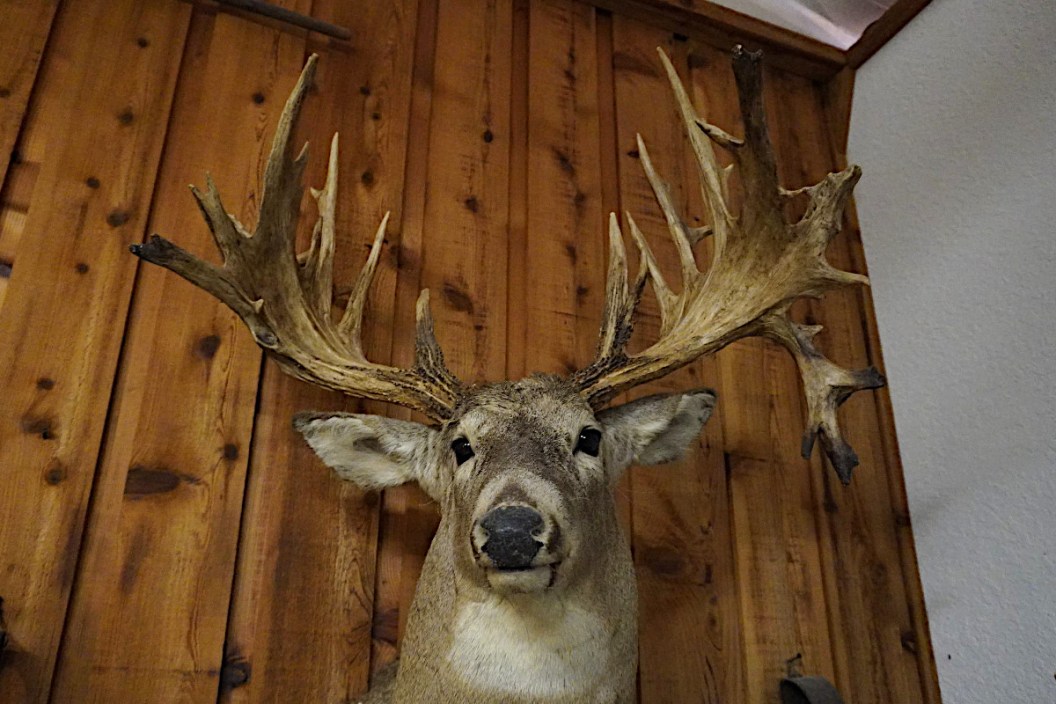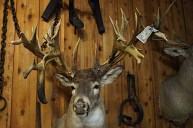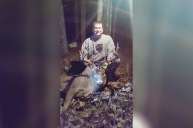They say records are made to be broken, but history has shown that some documents are much harder to break than others. A case in point is the Maine state record for a non-typical whitetail. The state has a rich whitetail hunting heritage and history, yet no one has been able to top the massive buck that Hill Gould shot back in 1910. Yes, Maine's state record is more than a century old and has no significant contenders! We know Maine is unique because it's not known as a state for big racks. It doesn't have the incredible genetics or nutrition from agriculture like Iowa or Kansas. The hunting is also harder, taking place in more big woods areas. In typical northeastern tradition, most Maine hunters care more about a buck's weight than its antlers.
Still, it's surprising to hear how long the Pine Tree State's record non-typical has stood. That is until you see the buck's antlers for yourself. Gould's buck has 31 points and a staggering amount of palmation, making it look more like a moose than a whitetail. Legend even has it that Gould thought he was shooting at a moose when this monster first stepped out in front of him! This is one of Maine's most extraordinary deer tales, and it's one that hunters are still sharing in camp more than 110 years after this great buck's harvest.
The Hunt for the Hill Gould Buck
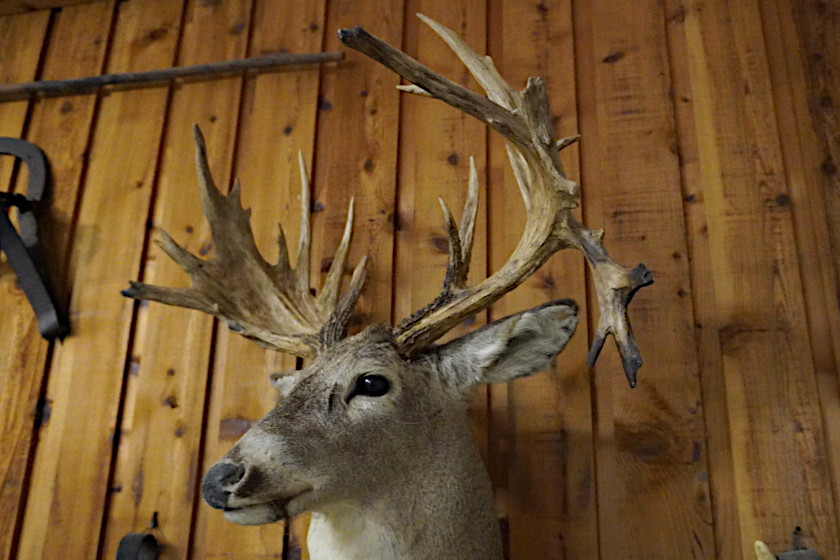
Travis Smola
In 1910, deer populations rebounded in many parts of North America. Unregulated market hunting had done several whitetails in many states. Maine was one of the smarter ones. They closed hunting to non-residents for more than 20 years in the mid-1800s, which likely helped keep deer populations a little more stable in Maine than in other areas. The fact there was a two-deer bag limit in 1910 is further testament to that.
According to North American Whitetail, Gould was just 15 years old at the time of his hunt for this great buck. He went out with his brother and friends near the town of Grand Lake Stream in the northern part of the state. Like many hunters at the time, the Gould brothers were more concerned about putting meat on the table than anything else. Gould's family still knows the exact location of the harvest, which today sits on public land that's part of the Downeast Lakes Land Trust. Gould found a comfortable spot overlooking a trail and settled to wait for deer. It wasn't long before Gould heard the tell-tale signs of something big approaching through some Alders.
Perhaps it's a bit of exaggeration added to the tale over the years, but legend has it that Gould saw the buck's massive antlers and thought he was looking at a moose at first. Moose numbers were dipping in Maine at that time. The story has gotten a bit muddled over the years as there's some question about whether moose was even in season. Either way, Gould decided to shoot the animal and soon found himself standing over the largest buck ever seen in Maine.
The story goes that Gould then carved out the buck's heart and liver and took it back to the hunting cabin, which wasn't far away. Legend has it that Gould walked in and unceremoniously dropped the organs on the table in front of his stunned friends without saying a word. That may be the best way anyone has ever told their buddies about the big buck they just shot. Upon seeing the massive size of the organs, his hunting buddies initially convinced Hill had killed a moose! All doubts about Hill's story faded when he took them back into the forest to recover the animal. Word about the giant buck spread fast. Even the Bangor Daily News ran a story about the monster buck.
How Big is the Hill Gould Buck?
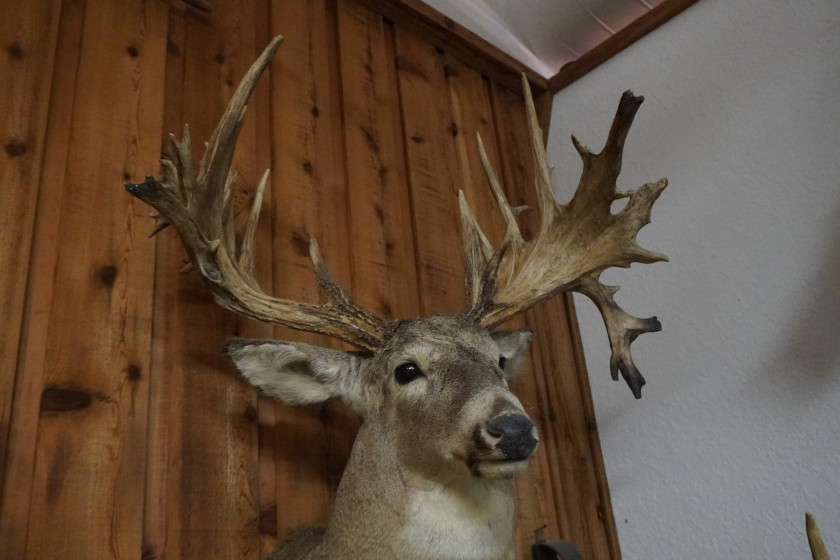
Travis Smola
Giant non-typicals were not common in this part of Maine, and many locals initially thought the buck had 52 points. They were measured by the ring-hanging method back then. The buck has 31 points over an inch in length using modern scoring practices. However, most hunters overlook this deer's points because the rack's most striking feature is the palmated, moose-like mass, which accounts for nearly 70 inches by itself! The three most significant circumference measurements are all over 10 inches, with the largest being a mind-blowing 13 inches! The buck's 6x6 specific frame measures over 200 inches, a feat for anywhere in the country. The extra drop tines and sticker points account for another 60+ inches of antler. The antlers score a whopping 259 inches, Boone & Crockett, making the Gould buck the state record and one of the largest deer ever taken in the Northeastern United States period. This buck accomplished a massive rack in a wilderness area with harsh winters and little nutrition. The era of high fences and genetic manipulation is a testament to how large deer can grow in the wild, given the right circumstances.
For the longest time, no one knew the exact score of the Gould buck. It was a famous deer in Maine for decades, but someone offered Hill $50 for the antlers shortly after the harvest. That was a lot of money back in 1910. He gladly took the offer. The antlers then hung at another hunting camp for a while before disappearing for decades. It's believed the buck changed hands in private collections several times. It wasn't until the 1980s that the rack finally resurfaced again. This time, it showed up at a hunting show, and scorers finally got the chance to put a tape on the deer. That's when it was confirmed and crowned as the Maine state record, which many hunters had already suspected it was anyway.
Hill later married and worked as a hunting guide in the years after his harvest. He became a household name to Maine hunters. He's still a legendary figure in the north woods to this day. One of the more remarkable aspects of this story is that Hill's grandson, Louis Cataldo, was greatly inspired by the tale of his grandfather's buck. As a result, Cataldo became an outspoken board member for the Downeast Lakes Land Trust, the non-profit organization that helped purchase and preserve public access to the land where Hill's buck was taken. The organization also preserved hundreds of thousands of acres surrounding it. Because of that effort, the area has changed very little since Hill shot the buck. That's not something you can say for every location that has produced a historical giant. We get the feeling Gould would be incredibly proud to see his legacy lives on and that his favorite hunting grounds have been saved for future generations to enjoy.
For more outdoor content from Travis Smola, follow him on Twitter and Instagram. Check out his Geocaching and Outdoors with Travis YouTube channels for original videos.
